Content is the best way to establish your organization’s credibility and win the trust of your target audience. In fact, 81% of B2B marketers in a Content Marketing Institute study felt that content marketing helped them raise brand awareness. 73% were able to educate their audience, while 68% found it helpful for building brand credibility and generating demand and leads.

So there’s no doubt that content marketing is effective for bolstering many aspects of your organization’s performance. But what if you’re not getting much ROI through your content marketing efforts? Or what if your ROI has been gradually dropping over the past few months? This could be a result of ineffective methods and strategies that yield subpar results.
If you want to boost your declining content marketing ROI, here are six effective steps you can take:
#1: Don’t Skimp on the Research Phase
This is where a lot of organizations go wrong. They’re in so much of a hurry to see results that they rush through the research process and create whatever content they feel will promote their products best. And they end up with content that their audience hardly engages with, not to mention notices.
Thorough research helps you gain the necessary data to build a solid foundation for your content marketing strategy. Otherwise, you’ll just blindly produce content that your audience doesn’t particularly like and promote it through platforms where you have limited reach.
There are multiple types of research you can conduct to fuel your content marketing strategy. But the most important types are audience research and keyword research.
Audience Research
Audience research helps you gain a real understanding of your audience, who they are, what they like, what their pain points are, what issues they face, and more.
So you’ll no longer be basing your content strategy on assumptions about who your audience is. This will help you develop a brand voice that would appeal to your target audience, brainstorm ideas for content that they would appreciate, find the most engaging channels, and more.
You can research your audience through website analytics, social media listening, and more. According to the previously-cited CMI study, 74% of B2B marketers also use sales team feedback to conduct audience research.
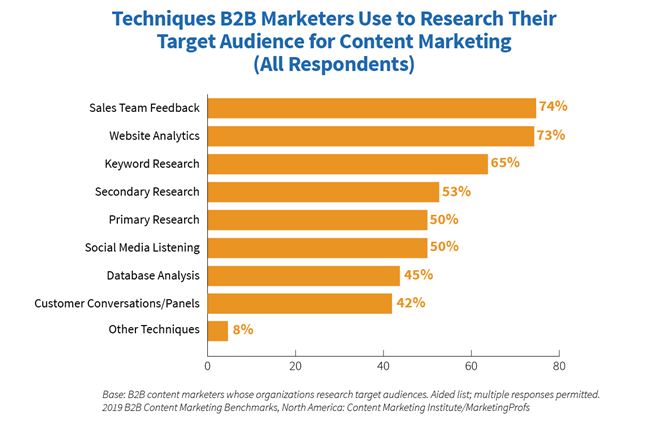
Image Source: The Content Marketing Institute
While only 42% of B2B marketers research their audiences by directly conversing with them, you should prioritize this technique. The best way to find out what your audience likes and dislikes is by asking them directly. You could conduct social media polls and website surveys to understand your audience better.
Keyword Research
Keyword research helps you find valuable and relevant keywords to optimize your content for visibility. Not only can you use these keywords to optimize your blog posts; you can also use them to optimize your social media posts, YouTube video descriptions, and more.
In addition, effective keyword research also helps you gain some clarity on user intent. In other words, it helps you understand what kind of content your audience is looking for and what kind of answers they need. Then you can prioritize on creating content to satisfy those needs.
#2: Prioritize Your Audience’s Informational Needs
The key to gaining better returns from your content marketing efforts is to produce content that has value to your target audience. Otherwise, you’ll just be spending time and money on creating content that gains little to no traction. But if you put your audience’s informational needs first, you’ll have no trouble reaping the benefits of your content marketing efforts.
In fact, 90% of the most successful B2B content marketers in the CMI study consider their audience’s informational needs as a top priority. They prioritize this even more than their own sales messaging, yet they’re still extremely successful in their content marketing efforts.
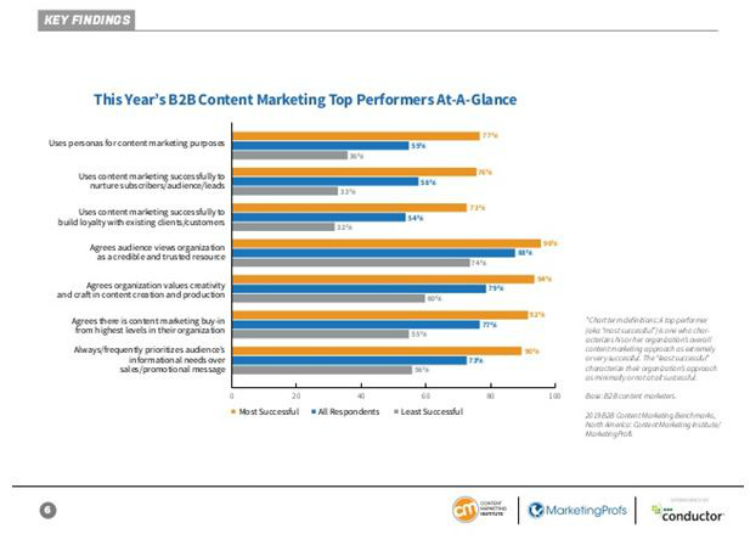
Image Source: The Content Marketing Institute
So if you want to boost your content marketing ROI, you need to create content that would satisfy the needs of your target audience.
Do they need help setting up or using your product? Will they be using your product to fulfill a specific function? What do they look for in a product?
This is where you can make the most of the insights you gained through research.
Use your audience research insights to understand their demographics, what roles they play in their company, what kind of problems they might be facing, etc. Then use this information to brainstorm ideas for content that would appeal to them and help them learn something valuable.
In addition to analyzing your top-performing content and surveying your audience, you can also conduct content research using BuzzSumo. This content research tool helps you identify the most shared and most engaging pieces of content in a specific domain or industry.
You can use these insights to identify what kind of content topics and formats are performing well in your industry.
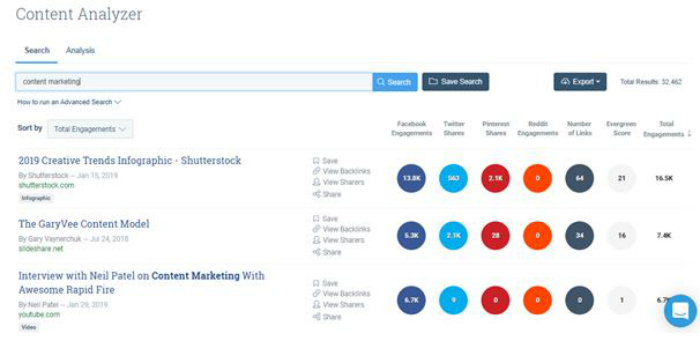
Image Source: BuzzSumo
In addition to this, you can also search for the most asked questions on a certain topic using Answer the Public. Just enter a search phrase and the tool will pull up data about what kind of questions people are asking and what kind of information they’re looking for. You’ll be able to come up with great content ideas using these insights.

Image Source: Answer the Public
#3: Amplify Content Performance with Engaging Influencers
As a business, there’s only so much you can do to promote your products or services without losing your audience’s trust. Salesy and overly promotional content can easily dissuade your audience. And sometimes, even the most compelling messaging may not be enough to convince people to buy your products.
That’s where influencers enter the picture. Since they’re real people, consumers find their opinions more trustworthy. There’s also the fact that these influencers tend to have some level of expertise in their respective niches. So people consider their opinions as expert recommendations that could influence their purchase decisions.
Since these influencers have massive reach, their involvement in your content marketing efforts could significantly amplify your results. You could have them share your content with their network to gain more visibility. But there are even better ways to work with industry influencers to boost your content marketing ROI:
Interview them for your blog posts, podcasts, live broadcasts, etc.
- Create roundup posts that involve multiple influencers.
- If they have a successful blog, submit guest posts that will appeal to their readers.
- Invite them to submit guest posts for your blog if they write blog posts.
- Have them review your products and create authentic content covering the review in detail.
- Have them take over your social media account for a day to engage your followers with Stories and posts.
- Invite them as guests for your webinar so you can produce high-quality, informative webinar content.
- If you can find influencers who are already fans of your brand, have them write testimonials for you.
- Feature them in your ad creative to gain a bigger impact for your paid campaigns.
These are just a few ideas that you can consider if you want to work with influencers and amplify your content marketing efforts. But whatever you do, make sure you’re very careful with your influencer selection. Not only do they have to be highly relevant to your brand, they should also be able to engage their audience.
Otherwise, you’ll end up wasting your time and money on influencers who aren’t a great fit for your brand. You can use the Influence.co Influencer Search feature to look for highly relevant influencers in your industry. You can then view the influencer profiles in your search results to see how much engagement they managed to drive on average.
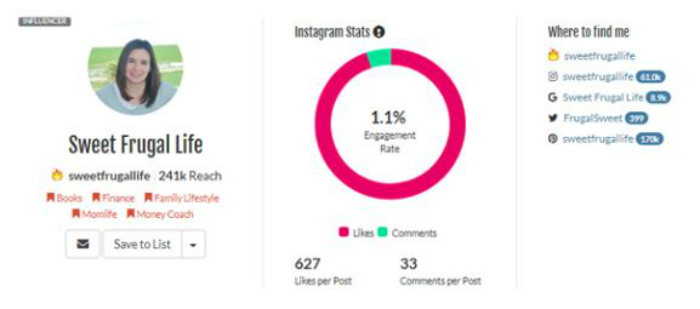
#4: Keep Updating Your Old Content
Content becomes out of date very easily. Especially if your industry is fast paced with new trends and rules popping up every other month. Even if you wrote a highly informative blog post that got thousands of shares, some of the information may become out of date within a year.
This means that readers will quickly lose interest once the information is no longer relevant. And with the waning engagement from readers, search engines will end up losing interest as well.
That’s why it’s crucial to keep your content fresh and relevant so you can always provide your readers with value and maintain search engine visibility.
While creating fresh content is definitely a must, you can save some time and effort by updating some of your outdated content as well.
Go to your website analytics and find the blog posts that are losing page views and engagement. Compile these posts into a list and go through each of them to see what kind of information you included, whether there’s scope for improvement, etc.
Perhaps you might be able to support your claims with new studies and examples. Or maybe some of the tips you provided have become too generic and needs a bit of sprucing up.
You could optimize the post with new highly-searched keywords to increase visibility. You might even see some scope for updating the content based on new policies, industry updates, new product features, etc.
Search Engine Journal has a robust content strategy, which heavily relies on content improvement and removal. One of their blog posts generated 22,000 reads and 2,000 page views per month on average in 2016. It was also ranking #2 in Google search results.
After refreshing it with updated information, the monthly page views increased more than twofold at 5,000 per month. It generated 64,000 reads and ranked on top of Google search results for the search term “marketing calendar.”
Parkway Digital also managed to improve their click-through rate from 1.4% to 20.8% using content improvement.
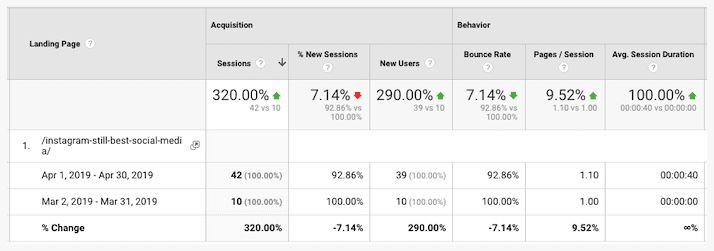
#5: Repurpose Your Most Successful Content
The key to boosting your content marketing ROI is to make the most out of the time, money, and effort you put into content research and development.
That way you’ll be getting more without having to spend double your resources. That’s why you should always try to get the most out of every piece of content you’ve created.
This means repurposing your existing content into other content formats so you can appeal to multiple interest groups. You won’t have to spend more time on content research and brainstorming topic ideas.
You just have to invest a little bit of time and resources on creating a fresh piece of content based off of your existing research.
The best way to get started is by finding your most successful pieces of content since you already know that they’re successful with your audience.
Go through your website analytics and see which blog post pages have the most page views and engagement. Compile them into a list and come up with ideas to repurpose the information you’ve shared through these posts.
You could turn your blog posts into infographics or pick out bite-sized information and share it through original social media graphics. You could turn your podcasts into blog posts, blog posts into videos and whitepapers, and more.
HighSpark’s Eugene Cheng repurposed his content into slides that he shared through SlideShare. Getting more views on his slides helped him gain 10,000 new subscribers.
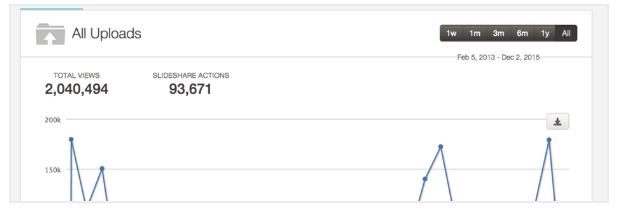
#6: Cross-Promote Content through Multiple Channels
If you want to get the most out of your content marketing efforts, you need to make sure that you’re distributing your content through the right channels. Make sure that you reach as many people as possible by cross-promoting your content through multiple channels.
This isn’t just limited to social media and email, but also through content aggregator sites, reputable publications, YouTube, SlideShare, and other channels that your audience frequent.
As you saw in the previously-cited case study, converting your blog posts into slides and sharing them through SlideShare can significantly boost your traffic.
Similarly, you could turn your blog posts into short video clips and share them through YouTube and other social media channels. Encourage viewers to check out the full blog post to learn more.
Or you could publish your YouTube videos on your blog with some text to further discuss the points in your video.
The options are virtually endless, so you can keep experimenting with multiple platforms and see what works best for you.
Final Thoughts
As you can see, there are tons of ways to boost your declining content marketing ROI. But you may not realize the full impact of these efforts if you don’t track your performance.
After every new strategy you’ve adopted, analyze the improvement in your performance and see what’s working for you. It’s crucial that you continually make adjustments in your strategy to further optimize your ROI.


